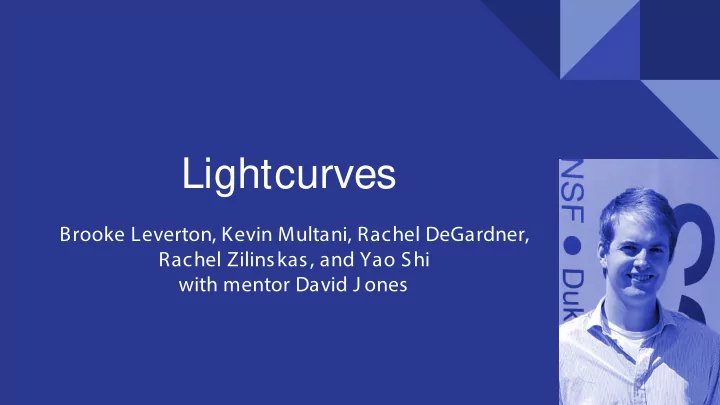

Lightcurves Brooke Leverton, Kevin Multani, Rachel DeGardner, Rachel Zilinskas, and Yao Shi with mentor David J ones
Outline The Lightcurve Problem Tree Classification Methods Feature Selection Results
Eclipsing Binaries Introduction PROBLEM EM : Classify different types of stars Data is collected for a large number of stars. The data are reduced to features which are then Pulsating Stars used for classification. TA TARGET: T: Classification accuracy based on three basic features provided by Catalina Real-Time https://www.eso.org Transients Survey (CRTS) [1] is 65. 65.1% 1% https://www.spacetelescope.org
Solution DAT ATA: A: Raw lightcurves with three basic features PROCESS: SS: Compute additional features ( FATS package in Python) Implement algorithm for classification ( randomForest in R)
Classification Trees A hierarchy of binary decisions to assign labels to different objects ages : Simplistic and can be Advan antag interpreted easily. ages : Not very accurate and Disad advan antag can be unstable.
Classification Trees X 1 > 6 N Y X 2 X 1
Bootstrap Aggregation (Bagging) Tree Bagging ● ages: Reduces the variance of prediction Advan antag ● ages: Trees highly correlated, causing bias Disad advan antag
Random Forests Prin incip iple le: Does bagging, but also randomly selects choice of features at each decision node. This decorrelates the trees. The final class is chosen by majority voting among the trees. R P Pac ackag age ran andomForest: Helps identify the features that are most important for classification Number of features randomly selected at each node and number of trees can be altered [3] Image Credit: http://www.synkee.com/clipart/forest-clip-art.htm
Lightcurve Data
Features CRTS Fea eatures es: Mean magnitude, period, and range for each observed star. Random Forest classification accuracy is 65.1%. Fea eature e Analysis for T Time S e Ser eries es (FATS) A library coded in Python that standardizes feature extractions for time series data, such as lightcurve data. Created by Isadora Nun, Pavlos Protopapas, and many contributors [4] . The raw lightcurve are inputted and it computes more than 50 new features.
Methodology
Feature Importance
Out of Bag Error Rate vs. Number of Features Used
Selected Feature Importance
Results Accuracy for Star Classifications Accuracy to beat 65.1% Training data 81.43% Testing data 81.59% Secondary Goal - Eclipsing Binaries Correctly Classified as Eclipsing Binaries Accuracy to beat 67.5% Training data 89.54% Testing data 90.60%
Moving Forward Limitations ns and nd F Fut utur ure W Work Study was limited to periodic star classification Extension to include aperiodic stars Extend study to explore other classifiers Support Vector Machine Boosted Trees Further feature analysis for optimal combination U i d l t i th d
References [1] Drake, A. J ., M. J . Graham, S. G. Djorgovski, M. Catelan, A. A. Mahabal, G. Torrealba, D. GarcÃa-Ã� lvarez, C. Donalek, J . L. Prieto, R. Williams, S. Larson, E. Christen Sen, V. Belokurov, S. E. Koposov, E. Beshore, A. Boattini, A. Gibbs, R. Hill, R. Kowalski, J . J ohnson, and F. Shelly. "The Catalina Surveys Periodic Variable Star Catalog." The Astrophysical J ournal Supplement Series 213.1 (2014): 9. Web. [2] Richards, J oseph W., Dan L. Starr, Nathaniel R. Butler, J oshua S. Bloom, J ohn M. Brewer, Arien Crellin-Quick, J ustin Higgins, Rachel Kennedy, and Maxime Rischard. "On Machine-Learned Classification Of Variable Stars With Sparse And Noisy Time-Series Data." The Astrophysical J ournal 733.1 (2011): 10. Web. [3] Breiman, Leo, and Adele Cutler. "Random Forests." Random Forests. N.p., n.d. Web. 17 May 2017. <https://www.stat.berkeley.edu/~breiman/RandomForests/>. [4] Nun, Isadora, Pavlos Protopapas, Brandon Sim, Ming Zhu, Rahul Dave, Nicolas Castro, and Karim Pichara. "FATS: Feature Analysis for Time Series." [1506.00010] FATS: Feature Analysis for Time Series. N.p., 31 Aug. 2015. Web. 17 May 2017.
Special Thanks! ● David Jones ● Sujit Ghosh ● Thomas Gehrmann
Recommend
More recommend